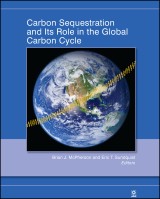Details

Carbon Sequestration and Its Role in the Global Carbon Cycle
Geophysical Monograph Series, Band 183 1. Aufl.
|
119,99 € |
|
| Verlag: | Wiley |
| Format: | |
| Veröffentl.: | 25.04.2013 |
| ISBN/EAN: | 9781118672358 |
| Sprache: | englisch |
| Anzahl Seiten: | 359 |
DRM-geschütztes eBook, Sie benötigen z.B. Adobe Digital Editions und eine Adobe ID zum Lesen.
Beschreibungen
Published by the American Geophysical Union as part of the Geophysical Monograph Series, Volume 183.<br /><br />For carbon sequestration the issues of monitoring, risk assessment, and verification of carbon content and storage efficacy are perhaps the most uncertain. Yet these issues are also the most critical challenges facing the broader context of carbon sequestration as a means for addressing climate change. In response to these challenges, <i>Carbon Sequestration and Its Role in the Global Carbon Cycle</i> presents current perspectives and research that combine five major areas: <ul> <li>The global carbon cycle and verification and assessment of global carbon sources and sinks</li> <li>Potential capacity and temporal/spatial scales of terrestrial, oceanic, and geologic carbon storage</li> <li>Assessing risks and benefits associated with terrestrial, oceanic, and geologic carbon storage</li> <li>Predicting, monitoring, and verifying effectiveness of different forms of carbon storage</li> <li>Suggested new CO2 sequestration research and management paradigms for the future.</li> </ul> <p>The volume is based on a Chapman Conference and will appeal to the rapidly growing group of scientists and engineers examining methods for deliberate carbon sequestration through storage in plants, soils, the oceans, and geological repositories.</p>
<p>Preface<br /> <i>Brian McPherson and Eric T. Sundquist</i> vii</p> <p>An Introduction to Global Carbon Cycle Management<br /> <i>Eric T. Sundquist, Katherine V. Ackerman, Lauren Parker, and Deborah Huntzinger</i> 1</p> <p><b>Section 1: Monitoring the Global Carbon Cycle: A Tribute to David Keeling 25</b></p> <p>The Mauna Loa Carbon Dioxide Record: Lessons for Long-Term Earth Observations<br /> <i>Eric T. Sundquist and Ralph F. Keeling</i> 27</p> <p>The Influence of David Keeling on Oceanic CO2 Measurements<br /> <i>Peter G. Brewer</i> 37</p> <p>Next-Generation Terrestrial Carbon Monitoring<br /> <i>Steven W. Running, Ramakrishna R. Nemani, John R. G. Townshend, and Dennis D. Baldocchi</i> 49</p> <p><b>Section 2: Assessment of Local and Regional Carbon Sources and Sinks 71</b></p> <p>Terrestrial Biological Sequestration: Science for Enhancement and Implementation<br /> <i>Wilfred M. Post, James E. Amonette, Richard Birdsey, Charles T. Garten Jr., R. Cesar Izaurralde, Philip M. Jardine, Julie Jastrow, Rattan Lal, Gregg Marland, Bruce A. McCarl, Allison M. Thomson, Tristram O. West, Stan D. Wullschleger, and F. Blaine Metting</i> 73</p> <p>Satellite Data Analysis and Ecosystem Modeling for Carbon Sequestration Assessments in the Western United States<br /> <i>Christopher Potter, Matthew Fladeland, Steven Klooster, Vanessa Genovese, Seth Hiatt, and Peggy Gross</i> 89</p> <p>An Inventory of Carbon Storage in Forest Soil and Down Woody Material of the United States<br /> <i>Charles H. Perry, Christopher W. Woodall, Michael C. Amacher, and Katherine P. O'Neill</i> 101</p> <p>Quantifying the Spatial Details of Carbon Sequestration Potential and Performance<br /> <i>Shuguang Liu</i> 117</p> <p>Soil Inorganic Carbon Sequestration as a Result of Cultivation in the Mollisols<br /> <i>Elena Mikhailova, Christopher Post, Larry Cihacek, and Michael Ulmer</i> 129</p> <p>Natural Analogs of Geologic CO2 Sequestration: Some General Implications for Engineered Sequestration<br /> <i>Julianna E. Fessenden, Philip H. Stauffer, and Hari S. Viswanathan</i> 135</p> <p>Hydrogeochemical Characterization of Leaking, Carbon Dioxide-Charged Fault Zones in East-Central Utah, With Implications for Geological Carbon Storage<br /> <i>Jason E. Heath, Thomas E. Lachmar, James P. Evans, Peter T. Kolesar, and Anthony P. Williams</i> 147</p> <p><b>Section 3: Assessing Risks, Benefits, and Impacts of Sequestration 159</b></p> <p>Is There an Optimal Timing for Sequestration to Stabilize Future Climate?<br /> <i>Vincent Gitz, Philippe Ambrosi, Bertrand Magné, and Philippe Ciais</i> 161</p> <p>Present and Future Changes in Seawater Chemistry due to Ocean Acidification<br /> <i>Richard A. Feely, James Orr, Victoria J. Fabry, Joan A. Kleypas, Christopher L. Sabine, and Christopher Langdon</i> 175</p> <p>Erosion of Soil Organic Carbon: Implications for Carbon Sequestration<br /> <i>Kristof Van Oost, Hendrick Van Hemelryck, and Jennifer W. Harden</i> 189</p> <p>Assessing the Potential for CO2 Leakage, Particularly Through Wells, From Geological Storage Sites<br /> <i>Stefan Bachu and Michael A. Celia</i> 203</p> <p>Scoping Calculations on Leakage of CO2 in Geologic Storage: The Impact of Overburden Permeability, Phase Trapping, and Dissolution<br /> <i>Christine Doughty and Larry R. Myer</i> 217</p> <p>Geochemical Impacts of Sequestering Carbon Dioxide in Brine Formations<br /> <i>John B. Kaszuba and David R. Janecky</i> 239</p> <p>Quantification of CO2 Trapping and Storage Capacity in the Subsurface: Uncertainty due to Solubility Models<br /> <i>Biniam Zerai, Beverly Z. Saylor, and Douglas E. Allen</i> 249</p> <p>Quantification of CO2 Flow and Transport in the Subsurface: Uncertainty due to Equations of State Algorithms<br /> <i>Weon Shik Han and Brian J. McPherson</i> 261</p> <p><b>Section 4: Evaluation of Carbon Management Requirements 279</b></p> <p>Verification and Accreditation Schemes for Climate Change Activities: A Review of Requirements for Verification of Greenhouse Gas Reductions and Accreditation of Verifiers—Implications for Long-Term Carbon Sequestration<br /> <i>Trygve Roed-Larsen and Todd Flach</i> 281</p> <p>Sociopolitical Drivers in the Development of Deliberate Carbon Storage<br /> <i>Jennie C. Stephens</i> 293</p> <p>Considerations for Monitoring, Verification, and Accounting for Geologic Storage of CO2<br /> <i>Mike Monea, Ray Knudsen, Kyle Worth, Rick Chalaturnyk, Don White, Malcolm Wilson, Sean Plasynski, Howard G. McIlvried, and Rameshwar D. Srivastava</i> 303</p> <p>Integrating Terrestrial Sequestration Into a Greenhouse Gas Management Plan<br /> <i>Joel R. Brown and Neil Sampson</i> 317</p> <p>A Conceptual Framework for Management of Carbon Sequestration Data and Methods<br /> <i>Robert B. Cook, Wilfred M. Post, Leslie A. Hook, and Raymond A. McCord</i> 325</p> <p>Looking Ahead: Research Agenda for the Study of Carbon Sequestration<br /> <i>Brian J. McPherson</i> 335</p> <p>Index 359</p>
<p>Brian J. McPherson and Eric T. Sundquist are the authors of Carbon Sequestration and Its Role in the Global Carbon Cycle, published by Wiley.

















